The Supreme Court Has A First Amendment Problem Right At Its Front Doorstep
The Roberts court has been very good on First Amendment issues, but it needs to address the First Amendment issue right outside its front windows.
One of the more interesting legacies of the Supreme Court under Chief Justice John Roberts to date has been the extent to which, even though the Court is arguably dominated by conservatives, the Court has been quite aggressive in dealing with challenges to free speech under the First Amendment. In various cases, the Court has set aside a civil verdict against the Westboro Baptist Church on the ground that even offensive speech is protected by the First Amendment, struck down a law that made it a crime to falsely claim military honors, struck down a California law restricting the sale of “violent” video games, allowed a suit against an Ohio law banning “false” campaign speech to go forward, and struck down a Massachusetts law establishing a protest buffer zone around abortion clinics. More controversially, the Court has handed down decisions in cases such as Citizens United v. FEC and McCutecheon v. FEC in which it clearly sided with the right of parties to engage in political speech over the power of the state to regulate or even ban that speech in the name of some vague notion of public integrity. While the last two cases were closely divided, many of these cases were unanimous or near unanimous. Notwithstanding this excellent record on what many would consider the most fundamental right that the Bill of Rights protects, though, New York Times Supreme Court reporter Adam Liptak notes that, while the Justices have been quite aggressive in protecting First Amendment rights in the cases that have become before them, there is a First Amendment free zone right on their front doorstep:
[T]he Supreme Court’s devotion to the First Amendment has its limits. It stops at the edge of the grand marble plaza outside its own courthouse.
That vast and inviting space, with its benches and fountains, seems better suited to public debate than a military funeral or the sidewalk outside an abortion clinic. But the court insists on banning free speech on the plaza. Court police officers have been known to instruct visitors to remove small buttons bearing political messages.
Last year, a federal judge struck down the law that bans protests on the plaza, calling it “irreconcilable with the First Amendment.” Pamela Talkin, the marshal of the Supreme Court, appealed the decision, and last month, a three-judge panel of the United States Court of Appeals for the District of Columbia Circuit heard arguments.
The case involves Harold H. Hodge Jr., a student from Maryland who was arrested on the plaza in 2011. His crime was wearing a sign that read, “U.S. Gov. Allows Police to Illegally Murder and Brutalize African Americans and Hispanic People.”
Such a statement, on a topic of urgent public interest, would seem to be precisely what the First Amendment was intended to protect. Then again, a Supreme Court police officer once threatened a woman with arrest for displaying a sign bearing the verbatim text of the First Amendment.
The law invoked by the officers, enacted in 1949, bars “processions or assemblages” or the display of “a flag, banner or device designed or adapted to bring into public notice a party, organization or movement” in the Supreme Court building or on its grounds.
The Supreme Court addressed the law in 1983, in United States v. Grace, ruling that it could not be applied to demonstrations on the public sidewalks around the court. Since then, the sidewalks, which are broad and set off by stairs from the plaza, have been regularly used for protests of all kinds.
But the First Amendment vanishes when concrete turns to marble, Justice Department lawyers representing Ms. Talkin told the appeals court. Their primary argument for the distinction was a curious one.
“Demonstrations outside courthouses might give rise to actual or apparent efforts to subject judicial officers to improper influence,” they said in a brief.
The idea that the justices would actually be swayed by protest signs on the plaza borders on the silly. If they were susceptible to that sort of influence, there would be no reason to think that signs on the sidewalk would be less effective.
That leaves the question of public perception. In the 1983 decision, the court said the law might be justified by a desire to prevent the public from thinking “that the Supreme Court is subject to outside influence.”
The fear here is not that the justices would in fact respond to protests, but that people would mistakenly think they did. That is not a flattering view of the populace.
It is also at odds with one of the core messages of the Citizens United decision, which assumed that people in a democracy would respond with skeptical discernment to the political messages that bombard them before elections.
We honor the First Amendment, Justice Anthony M. Kennedy wrote for the majority, by allowing everyone to speak and “entrusting the people to judge what is true and what is false.”
The current restrictions, as well as the Court’s holding in the Grace case seem particularly out of tune with current First Amendment law given the Supreme Court’s decision in McCullen v. Coakley, the case dealing with a Massachusetts law that created a 35 foot buffer zone around abortion clinics within which protesters were prohibited, even if that meant restricting access to public sidewalks and other public property. In its unanimous decision, the Court stated that the fact that protest was allowed outside the buffer one was irrelevant because of the fact that it meant that, inside the zone, the protests could be seen but not heard. The Court’s opinion didn’t reject the idea of some kind of protective zone entirely, but in effect the ruling means that protesters can not be restricted by the physical distance from the building, although actual physical contact with clinic workers or In a concurrence joined by Justices Alito and Thomas, Justice Scalia said that the Court should have struck down the law in its entirety, effectively arguing that any restriction on protesters that can’t legitimately be tied to public safety concerns is per se unconstitutional.
Given that ruling, it’s hard to see how a blanket ban on protests of any kind can withstand scrutiny. Obviously, authorities would still be within their rights to regulate the time, place and manner of large protests and the like as long as they are doing so in a manner that isn’t based on the content of the speech in question. As a general rule, though, a blanket ban on any protests at all, or indeed just a simple act of free speech such as a sign containing a political message such as the one at issue in the case described above, would seem to clearly be unconstitutional. Additionally, the distinction that the current law makes between the plaza itself and the sidewalk that it is right in front of is clearly a distinction without a difference. A protest in the plaza is no more likely to assault the integrity of the Court in the eyes of the public than one on the sidewalk would, and the idea that the Justices are going to be any more swayed because protesters have moved the few feet involved in going from the sidewalk to the plaza is really quite absurd. As with any building in Washington, there are obvious security concerns that would have to be dealt with in allowing protests on the plaza, but it doesn’t seem to me as though the security burden would be any greater than it already is when large groups gather on the sidewalks in front of the Court, mostly to appear for the cameras that inevitably show up when they do.
The Roberts Court has been very good when it comes to First Amendment issues, and for that they deserve recognition and thanks. However, they have a First Amendment issue that is quite literally on their doorstep that needs to be dealt with if they are going to be consistent with the principles they’ve set forth in the cases that they’ve decided.
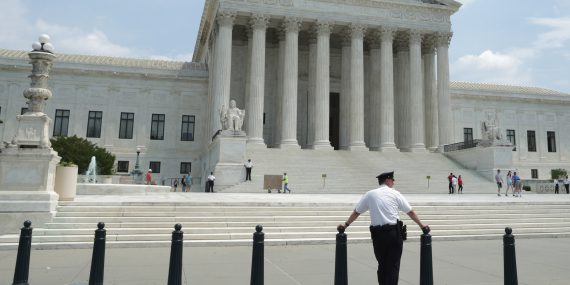

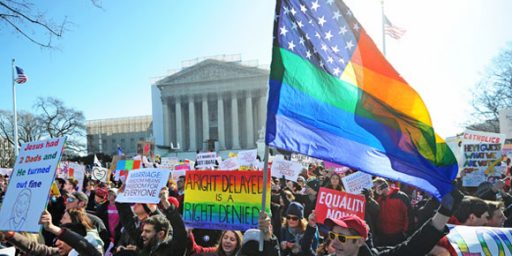
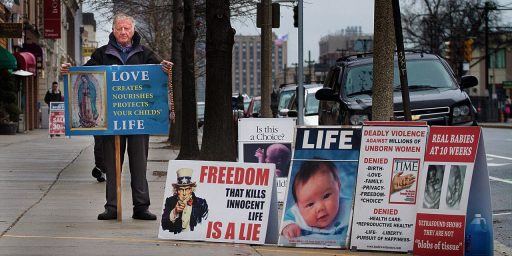
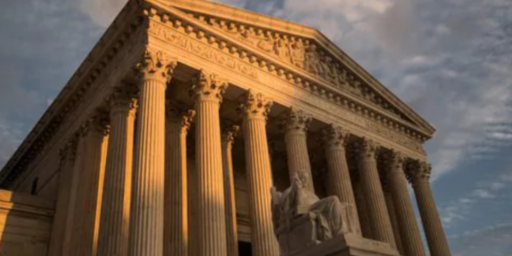
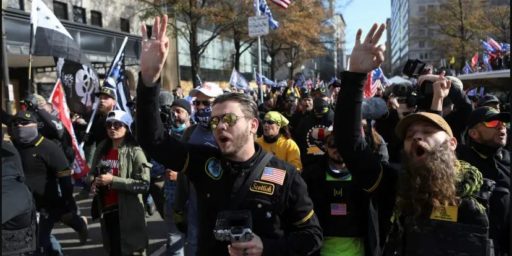
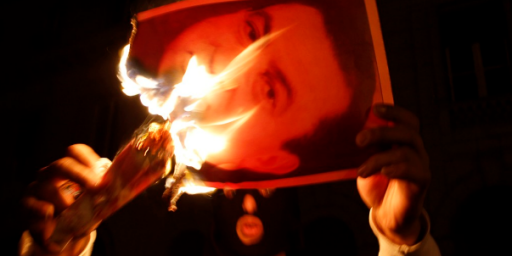
Repeat after me: First Amendment is for godly men and women seeking to instruct sluts seeking abortitons about the error of their ways, not for any other purpose.
After all, are we not a nation established in the spirit of Religious Freedom(TM)??
Well it’s worth noting that the Court has not ruled on this issue since 1983, and this case isn’t really before SCOTUS yet (since its a Federal law they can’t change policy on their own).
Just organize everyone to send them a few thousand amicus briefs, maybe they’ll like signs better
Doug- OT but this is so good I had to share it.-I don’t know if you’ve wasted any of your brain cells in morbid curiosity on that gamer geek temper tantrum called GamerGate, but I found this response to twitter trolling hilarious.
I once photographed some friends of mine doing a Busby Berkeley routine down the Supreme Court building steps, and les flics didn’t have a problem with that. Maybe dance is an acceptable form of cultural expression at that venue.
It seems to me that this business of the “Supreme” Court not taking its own medicene happens a lot. Maybe there should be some law passed that requires the “Supreme” Court to abide by their own rulings. I wouldn’t doubt that they have some special waiver or exemption concerning the “Affordable Health Care”.
@Tyrell:
You should doubt that. Blue Cross Blue Shield Federal Employees coverage like all other employees.
And yes, they pay for roughly half of the expense.
There’s something disturbing about protesting in front of the Supreme Court building. It’s so third-world. There are a lot of buildings in Washington that represent, or house, the democratic branches of government. Protesting in front of the Court is either very obtuse or very cynical.
@Pinky: Huh? Where did you get the idea that demonstrating in front of a supreme legal building is third-world? Examples from history, please….
I suspect that the intent of the original law was (at least in part) to ensure that the Court was not even aware of how the public felt on a particular issue, or whether there was a vocal opposition or advocacy. Naive, but possible in an era of local newspapers and radio.
These days, the internet makes that idea somewhat quaint. Although I could believe that some of our current crop of Justices are sufficiently Luddite that they still live in a little bubble of news deprivation…